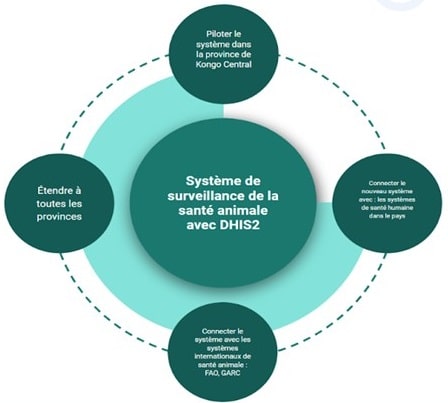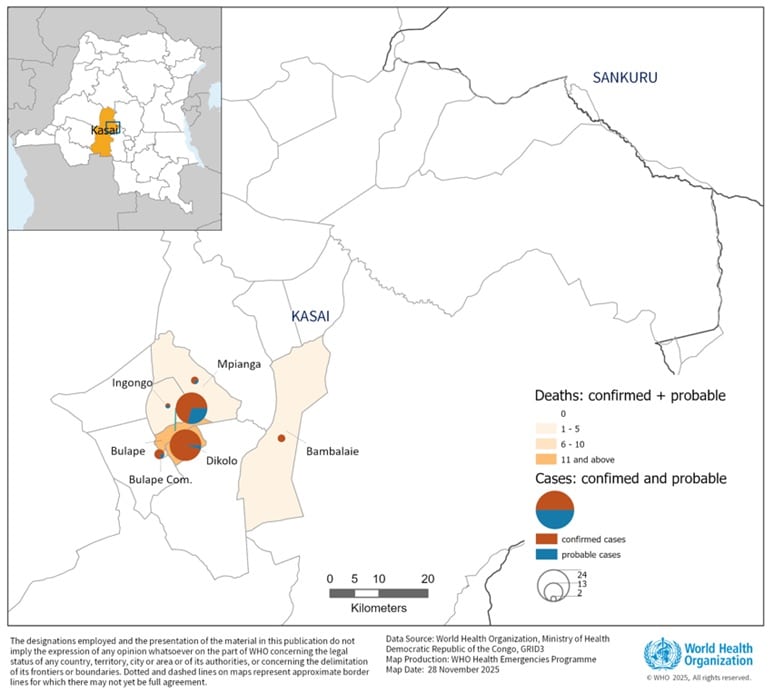
Strengthening animal health and zoonotic surveillance in the Democratic Republic of Congo with DHIS2
With HISP support, agricultural and health authorities in the DRC have strengthened the surveillance system in the province of Kongo Central, enabling the collection of data on animal vaccination, animal bite cases, and laboratory data to improve real-time analysis.
It is currently estimated that 75% of emerging infectious diseases worldwide originate from domestic or wild animals. The Democratic Republic of Congo (DRC) is the second largest country in Africa, with an area of over 2.345 million km² and a population of around 90 million people. The country’s size, population, biodiversity, and location (surrounded by 9 neighboring countries) make it particularly vulnerable to zoonotic diseases. In recent decades, the country has experienced several epidemics of zoonoses, including Ebola, rabies, and mpox. Between January and August 2024, the DRC recorded 16,706 suspected cases of mpox, making it the country most affected by this recent epidemic.
These factors highlight the need for an effective response plan based on strengthening the surveillance system, raising public awareness, and mass vaccination campaigns. To combat the spread of all emerging and re-emerging zoonoses, close collaboration, communication and coordination between the Animal Health, Public Health and Environment sectors are crucial. The One Health concept provides a useful framework for approaching these challenges.
In January 2023, HISP WCA, HISP DRC and HISP UiO initiated a pilot project in the Kongo Central province of DRC to strengthen the surveillance and response system, through the configuration of DHIS2 Tracker for individual data collection. The objectives of this pilot project are to extend the system to all animal and zoonotic diseases, to integrate laboratory data and animal vaccination data, and to monitor bite cases, including snake bites.
“DHIS2 facilitates the rapid transmission of information on disease outbreaks, with structured data archiving. Reports on diseases with high epidemic or zoonotic potential are generated systematically and sent in real time, enabling effective monitoring. In addition, the integration of laboratory data and the in-depth analyses available enhance our ability to make informed decisions at strategic meetings, improving our responsiveness to health crises.”
Fidèle Lama, Data Manager, SENES, Ministry of Fisheries and Livestock

Setting up an effective monitoring system for all zoonoses with DHIS2
In 2021, the FAO and the DRC’s Ministry of Fisheries and Livestock set up the EMA-I-EMPRESS system for animal health surveillance. However, the platform had its shortcomings. To start with, its data was hosted in another country on the FAO’s server, and was thus difficult to access in real time for data analysis by DRC authorities. What’s more, the data in this system only concerned animal-specific diseases, with few zoonoses included. The system also lacks laboratory data, animal vaccination data, and bite monitoring.
To complement this existing system, in November 2021, the Global Alliance for Rabies Control (GARC), in collaboration with the Ministry of Fisheries and Livestock, began implementing DHIS2 in Kongo Central for the collection and analysis of rabies data using the rabies vaccination form and the injury case follow-up form.
Aware of the shortcomings of existing systems, in December 2022, Institut National de Recherche Biomédicale (French National Institute for Biomedical Research) (INRB), in collaboration with the Provincial Coordination of the National Epidemiosurveillance Service (SENES), and the Provincial Office of Veterinary Services within the Ministry of Fisheries and Livestock, as well as National Pedagogical University, called on HISP WCA, HISP DRC, and HISP UiO to strengthen the surveillance and response system already set up by GARC by extending it to all animal and zoonotic diseases, and integrating laboratory data, animal vaccination data, and bite monitoring.

Configuring an integrated animal & zoonotic surveillance system in Kongo Central
The province of Kongo Central covers an area of 53,947 km², 2.3% of the country’s total area, and has a population of 6,838,500. The risks of zoonosis transmission are particularly high, and the animal and zoonotic diseases detected range from African Swine Fever to Scabies and Rabies. These have a significant economic and social impact, contributing to the impoverishment of local communities as well as the country’s overall economy.
A one-year pilot project, financed by the CDC, was launched in January 2023, with the aim of collecting and managing information on 12 priority animal and zoonotic diseases: Ebola Fever, Rift Valley Fever, Avian Influenza, Mpox, Rabies, Salmonellosis, Contagious Bovine Peripneumonia, African Swine Fever, Ovine rinderpest, Newcastle disease, symptomatic anthrax and foot-and-mouth disease.
The first phase involved configuring the Animal Health Information Collection System, SISA DHIS2. This configuration aimed to use Tracker for individual data collection for the animal and zoonotic disease notification form—which includes laboratory results—as well as the dog, cat and snake bite case follow-up form. This innovation represents real added value, as in the case of bites, it is now possible to enter the reason and context of the injury, the vaccination status of the biting animal in DHIS2—which is connected with the vaccination form already in DHIS2 for all diseases— as well as its status: stray or known, domesticated, or wild.
For these three forms, 54 program indicators have been configured in DHIS2, such as alert thresholds, epidemic threshold, reported cases of zoonotic diseases, number of tests, test positivity rate, case fatality rates for different diseases, and data on vaccines administered.
Capacity building for efficient data collection and effective data use
The second phase of the pilot involves training computer specialists and epidemiologists from the National Epidemiosurveillance Service within the Ministry of Fisheries and Livestock in configuring Tracker for online event entry forms, as well as for data collection using the DHIS2 Android Capture application on mobile devices. This will allow them to maintain and update the DHIS2 system over time. The third phase focuses on the training of field workers within the health pyramid in charge of animal health surveillance to facilitate effective data collection and use:
- Provincial level: The SENES Head of Division and Head of Investigation ensure weekly data quality control. They will be trained in functionalities relating to dashboards and data quality within DHIS2.
- Territory level: The Chief Observation Officers (CPO) support the veterinary department heads in data entry. They consult the data relating to their respective entities and then draw up the weekly epidemiological surveillance report for transmission to the Provincial level. They will be trained in data entry and analytics tools.
- Sector level: Veterinary department heads will be trained in DHIS2 data entry to capture animal and zoonotic surveillance data.
Data entry in DHIS2 is carried out at the veterinary clinic level, but collaboration between veterinary clinics and other actors involved in disease and zoonosis detection—such as health centers, public slaughterhouses, farms, farming communities and owners of livestock and pets—remains essential.
When a veterinarian is notified of the detection of a potentially infected animal that is suspected of having bitten a person or that has died, an investigation is immediately carried out by the veterinary clinic to identify the context of the injury, the animal’s health and vaccination status. If necessary, a sample is sent to the laboratory. The veterinary report and sampling information are then entered into the SISA DHIS2 with the Android app using the animal and zoonotic disease notification form.

Once the test results are known, the laboratory enters the results into DHIS2 by completing the laboratory section of the bite case follow-up form and specifying the test result, whether positive or negative. When the disease is confirmed, the results will also be entered on the disease notification form. These data are immediately accessible to stakeholders throughout the health pyramid at provincial and national level.
Real-time data support decision-making at provincial and national levels
At the provincial level, division heads and department heads view and analyze the DHIS2 dashboards on a daily basis. These visualizations integrate data on disease notification, injury tracking and vaccinated animals, allowing them to have an overview of trends in the various zoonoses monitored and other key indicators. They are also in charge of the surveillance system’s response in the case of early detection of outbreaks, deploying of resources as needed to help contain the disease. A report generated from this data is presented to SENES of the Ministry of Fisheries and Livestock at weekly meetings attended by all DRC provinces.
“DHIS2, integrated into our animal and zoonotic disease surveillance system, has proved remarkably useful in transforming our ability to monitor and manage data. As well as innovating with bite case tracking forms and those for recording animal vaccinations, this application now provides us with detailed statistics. This data is crucial for in-depth analysis and facilitates more informed and reactive decision-making, improving our health response. We look forward to implementing this application in other regions to enhance the effectiveness of our national system.”
Dr. Leonard Ntunuanga, Head of Service SENES, Kongo Central

To date, the SISA DHIS2 system includes 772 notified cases of animal and zoonotic diseases, 404 bite follow-up cases, and 3091 vaccinated animals. HISP WCA and HISP DRC have also initiated interoperability between the EMA-I-EMPRESS-I and SISA DHIS2, through the development of an application making case notification data available in Excel format for import into EMA-I-EMPRESS-I. This application facilitates the sharing of information with the FAO in particular.
However, other parts of the project remain to be completed. To date, some stakeholders remain to be trained on the use of the system, particularly at sector level. In addition, there are plans to add a feature that sends automated text messages to alert pet owners that their animals’ vaccinations are about to expire. Finally, an evaluation of the pilot project, based on feedback from current users, is also planned, which will inform future developments of the system in DRC.


